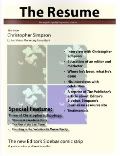Thurber's Legacy
The following is a reprint of the Ad Nauseam column which appeared in the September 23, 2008 edition of the Metaverse Messenger.
According to most pundits, the recent monetary crisis has dealt a devastating blow to the future of online, non-traditional advertising. “Are ‘experimental’ marketers doomed?” asks Adotas. “Credit crunch hits new ad technology” utters Utalk Marketing. “Investment in bullshit ads plummets,” gloats Gawker.
Kind of reminds me of the great High Street rout during the Ohio flood of 1913.
In March of 1913 Ohio experienced the worst natural disaster of its history when heavy rainfalls caused massive flooding of the region. The worst of it occurred along the Great Miami River, and in Dayton the flood water rose to twenty feet in the downtown core. The stress of the rushing waters ruptured gas lines causing fires that burned unchecked as the fire department watched helplessly, unable to gain access. In the end over 400 people died and more than 20,000 homes destroyed.
Although I was born and raised in Canada, I knew about the Ohio flood because it had been featured in a story by one of my favorite authors — James Thurber.
In his “The Day the Dam Broke,” Thurber tells of the teaming mass of humanity which fled down High Street in his hometown of Columbus, Ohio. “‘Go east!’ was the cry that arose,” he wrote. “East away from the river, east to safety. ‘Go east! Go east! Go east!’” As the panic took hold, more and more people joined the throng. “Black streams of people flowed eastward down all the streets heading in that direction.” Before it was over, some had run more than 12 miles to escape the raging waters.
Except, of course, in Columbus there weren’t any raging waters. The entire incident had been nothing more than a massive misunderstanding. “Suddenly somebody began to run,” says Thurber, suggesting the ultimate cause. “It may be that he had simply remembered, all of a moment, an engagement to meet his wife, for which he was now frightfully late.” Under normal circumstances, one person running would have been unremarkable, but with the flood waters rising in neighboring regions, any quick movement could be interpreted as an attempted escape from impending doom. “Inside of ten minutes, everybody on High Street, from the Union Depot to the Courthouse was running. A loud mumble gradually crystallized into the dread word ‘dam.’ ‘The dam has broke!’”
In a similar fashion, the recent panic concerning “experimental” advertising has been sparked by little more than a single voice: that of Emily Steel whose recent article in the Wall Street Journal appears to have set off a stampede with more than a few similarities to that which occurred in Columbus almost 100 years ago.
“In recent years,” she writes, “marketers have set aside a portion of their ad budgets to experiment with digital technologies such as Web video, mobile phones, gaming and virtual worlds. But with broader economic turmoil reaching Madison Avenue, these ‘experimental’ budgets are among the first to hit the cutting-room floor.”
From this single source, a tidal wave of acquiescence has arisen. And while there is undoubtedly cause for concern — just as in 1913 there were some very real flood waters in Ohio — Steel’s dash for safety may possibly be just a trifle premature.
Fortunately, not everyone has joined her in flight. Adam Needles, of Propelling Brands, offers a thoughtful critique of the Wall Street Journal piece, focusing especially on the author’s neglect to differentiate between the many different forms of “experimental” media.
“She makes broad-based assumptions in her piece about marketers’ priorities and about the capabilities of digital and new-media initiatives,” he writes. “She also lumps together everything from mobile marketing to place-based media to advertising on social-media sites to embedded advertising on games and virtual environments in the same boat. She finally ignores the blurring of the lines over time between traditional non-interactive advertising, on one hand, and emerging interactive PR/social-media based digital marketing programs, on the other hand — making it harder to substantiate the reality of the exodus she predicts.”
To Needles, Steel’s biggest mistake, however, is that “she is not thinking like a marketer.” And to a marketer, “[d]igital and new-media initiatives are, in fact, just what the doctor ordered in the current environment.”
When times get tough, the real marketer begins looking for the edge, and to Needles, the edge is in the new media. Citing such advantages as low cost, two-way communication through social networking sites, and improved tracking, he puts forward a compelling argument.
As for me — what do I know? I’m merely a hack with pretensions of mediocrity. But I can tell you this much: when the crowd starts to run from the flood waters, it can be damned hard to get them to stop. In Thurber’s account, militiamen attempted to restore order by riding about in trucks with megaphones calling, “The dam has not broken.” The immediate effect, however, was “to add to the confusion and increase the panic, for many stampeders thought the soldiers were bellowing, ‘The dam has now broken!’”





